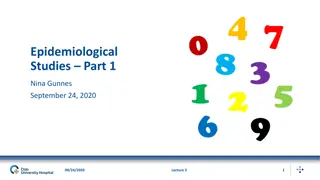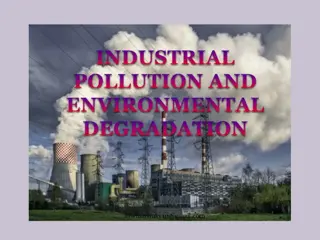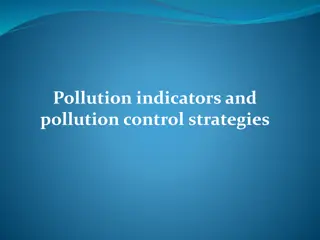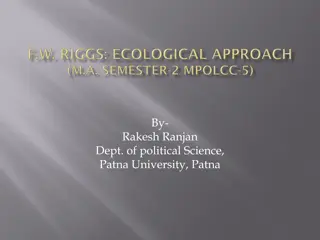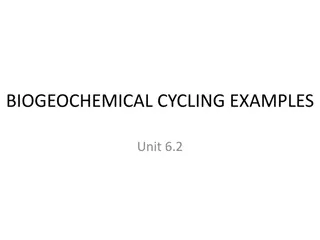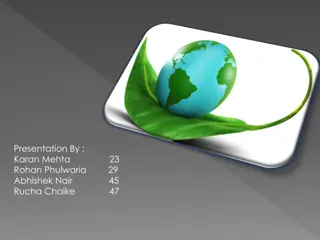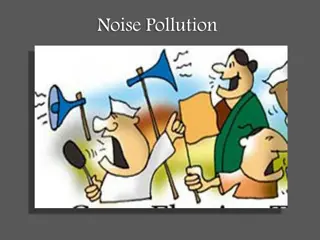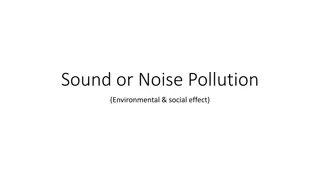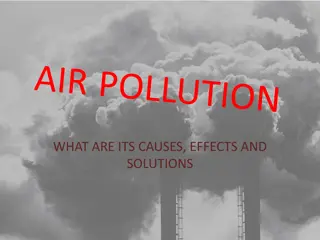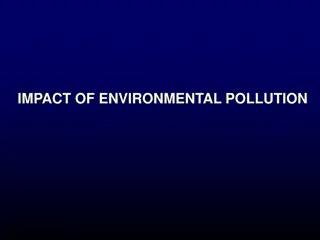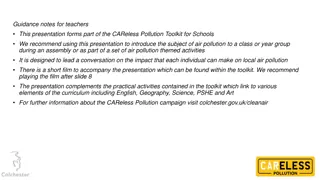Understanding Pollution and its Ecological Impact
Pollution is any human addition to the environment that disrupts the ecosystem's ability to sustain life. This includes pollutants like CO2 and chemicals from various sources that harm air, water, and land. Different types of pollution such as industrial, agricultural, and domestic pollution have adverse effects on the environment. Learning about pollutants, control mechanisms, and ecological impacts is vital in addressing this global issue.
Download Presentation

Please find below an Image/Link to download the presentation.
The content on the website is provided AS IS for your information and personal use only. It may not be sold, licensed, or shared on other websites without obtaining consent from the author. Download presentation by click this link. If you encounter any issues during the download, it is possible that the publisher has removed the file from their server.
E N D
Presentation Transcript
1.4.9 Human Impact on an Ecosystem 1 Pollution
Need to know Define the term: Pollution. State areas affected by pollution. State mechanisms to control pollution. Explain the difference between the terms pollutant and pollution. Discuss the ecological impact of one human activity. 2
Pollution What it is Types of pollution Pollutants Effects of pollutants Control of pollutants Ecological impact of one human activity 3
Pollution Pollution is any human addition (contamination) to a habitat or the environment that leaves it less able to sustain life. It is the most harmful human impact and affects air, fresh water, sea, soil and land. Chemicals of human origin that harm the environment are called pollutants. 4
Industrial/Air Pollution File:AlfedPalmersmokestacks.jpg Agricultural Pollution slurry, if it gets into a river/pond Some types of Pollution Domestic Pollution http://upload.wikimedia.org/wikipedia/commons/thumb/7/7c/Litter.JPG/220px-Litter.JPG River/Water Pollution 5
Learning check Explain the difference between Pollution and Pollutant Pollution is any human addition (contamination) to a habitat or the environment that leaves it less able to sustain life. Pollutants are chemicals of human origin that harm the environment. 6
Pollutants are produced by human activities CO2 from respiration is not a pollutant why? excess CO2 from burning fossil fuels is SO2 from marshes & volcanoes is not why? SO2 from factory chimney is 7
Pollutants Some pollutants are normally present in an environment, e.g. CO2, but levels are increased by human activity. Other pollutants never exist in an environment e.g. oil slick, CFCs 8
Learning check List some types of pollution Industrial Agricultural Domestic River/Water 9
From the Syllabus & Guidelines The Syllabus states: Study the effects of any one pollutant. The Guidelines for Teachers states: Give the effects of one pollutant from any of the following areas: domestic, agricultural, industrial. and Give an example of one way in which pollution may be controlled in the selected area. What follows is only a sample of the pollutants available. 10
Effect of one pollutant from one area - Agricultural, Industrial or Domestic Area Pollutant Source Washed or leached from land Burning fossil fuels Effects Formation of algal blooms and eutrophication Forms acid rain More detail later Non-biodegradable Suffocate small animals, Litter Slurry & Fertiliser Agricultural Sulphur dioxide Industrial Domestic Plastic bags Shopping 11
Eutrophication & Algal bloom eutrophication: a condition where lakes become over-enriched with nutrients, resulting from excess artificial fertilisers washed into rivers and lakes. There is a rapid increase in the growth of alga (algal bloom) as they use up the nutrients. When all the nutrients are used up the algae die and are broken down by bacteria, which use up the oxygen in the water resulting in the death of aquatic organisms such as fish. 12
Control of Pollutants in the selected area - Agricultural, Industrial or Domestic Area Pollutant Control Measures Avoid spreading these: on wet, waterlogged, frozen or steeply sloping land within 1.5m of any watercourse. Fit catalytic scrubbers in factory chimneys Slurry & Fertiliser Agricultural Sulphur dioxide Industrial Bag tax/levy. Reuse/Recycle bags Domestic Plastic bags 14
Learning check CO2 is produced by all living things as a reuslt of respiration. Is CO2 a pollutant? Explain your answer. No Explanation: Pollutants are produced by human activities CO2 from respiration is not a pollutant excess CO2 from burning fossil fuels is 15
Ecological impact of one human activity Burning Fossil Fuels
Acidic oxides and acid rain All rain is acidic but not the same pH CO2 in the air dissolves in rainwater to form carbonic acid pH = 5.5 in unpolluted air Acid rain refers to very acidic rain with a pH of 4.5 or less (Note: pH 4.5 is 10 times more acidic than pH 5.5) 17
Acid rain Burning of fossil fuels (e.g. ) releases acidic oxides into the air, especially SO2 and nitrogen oxides (NOx) SO2 dissolves in rainwater to form sulphurous acid (H2SO3) or reacts with particles in the air to form sulphuric acid (H2SO4) The resulting rain is very acidic and can be carried far by the wind 18
Effects of acid rain Reduces soil pH Phosphorus (P) binds to soil particles and is unavailable to plant roots Al becomes soluble and poisonous and with K, Ca and Mg is washed (leached) from the soil into lakes and water supplies Soil is impoverished and fish die in highly mineralised water. Why? 19
Effects of acid rain Erodes limestone buildings Causes breathing difficulties irritates the delicate lining of the lungs Inhibits chlorophyll formation and burns the leaves of plants 20
Learning check What is acid rain? Acid rain refers to very acidic rain with a pH of 4.5 or less How is acid rain formed? Burning fossil fuels releases SO2 and nitrogen oxides (NOx) SO2 dissolves in rainwater to form sulphurous acid (H2SO3) or reacts with particles in the air to form sulphuric acid (H2SO4) The resulting rain is acid rain 21
Effects of acid rain Acid rain is a trans-boundary problem i.e. it is formed in one country but transported or blown huge distances to another. Norway imported its acid pollutions from the English Midlands and the Ruhr valley in Germany. Ireland is lucky that the prevailing winds are from the Atlantic and not from Europe. 22
Dealing with acid rain Reducing the quantity of fossil fuels burned Using catalysts to treat chimney gases ( scrubbers are fitted to the insides of chimneys) Catalytic converters fitted to modern cars Developing alternative clean energy sources 23
Learning check List some of the effects of acid rain Reduces soil pH Phosphorus (P) becomes unavailable to plant roots Al, K, Ca and Mg is washed (leached) from the soil into lakes and water supplies Fish die in highly mineralised water Erodes limestone buildings Causes breathing difficulties Inhibits chlorophyll formation Burns the leaves of plants 24
END 25



